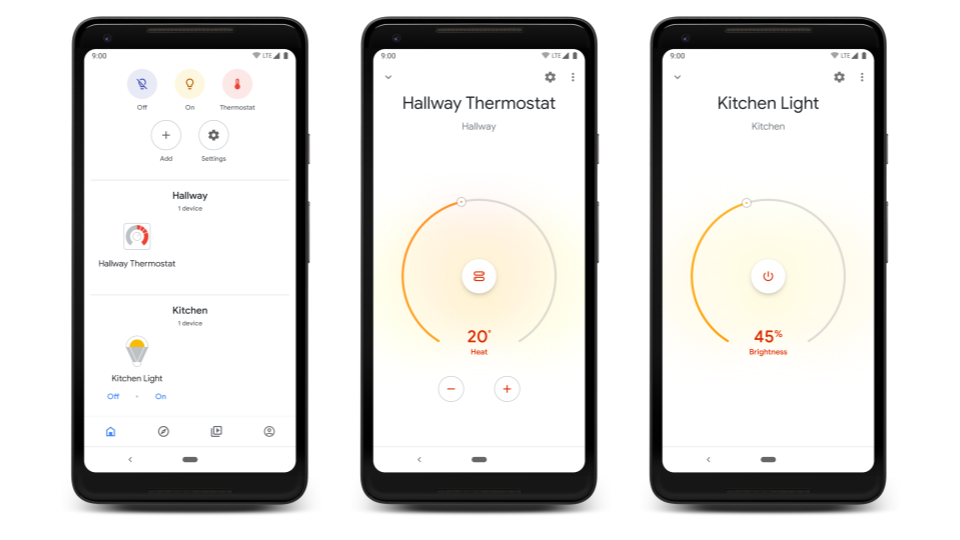
- #Where is the google home app for android full
- #Where is the google home app for android android
- #Where is the google home app for android plus
- #Where is the google home app for android windows
followed by the name of a contact or business or even just a number. When I need to make a call - whether it's ordering chow fun or performing Extremely Important Business Research (which may or may not involve broad noodles) - I don't lift a finger, hunt around for my phone, or stop whatever else I'm doing. So if you've got a spare Assistant gizmo sitting around or you're thinking about picking one up over the holidays, keep the following productivity-boosting possibilities in mind: 1. Using an Assistant speaker or screen also doesn't wear down your precious mobile battery, and the standalone nature of such devices actually makes 'em better suited for certain types of tasks. But performing a task on a dedicated, stationary device can often be easier and more effective than futzing around with your phone.
#Where is the google home app for android android
Now, is there a fair amount of overlap between what an Assistant-connected speaker or screen on your desk can do and what you could already do with your trusty Android phone? You'd better believe it.

I've had an Assistant-enabled speaker or screen on my own home office desk for a few years now, here at the world-famous Android Intelligence International Headquarters (located in a musty and foam-filled bunker deep within an elfin hollow), and I've gotta say: Despite the fact that these devices are marketed mainly for family-oriented, home-style use, there's something to be said for having one at your disposal during the workday - especially in a more solitary space. It's none other than the Google Assistant, and it lives in a variety of small speakers and even more sophisticated Smart Displays.
#Where is the google home app for android full
And no matter what type of work (or perhaps even non-work) you're doing, it'll always be full of energy and ready to help out in any way it can. It may not be able to do everything a human assistant can handle, but it'll be eagerly standing by and waiting in your home office - perched jauntily atop your desk, even - at every waking hour. Well, my friend, allow me to introduce you to your new on-demand associate. You've got less equipment, less face-to-face collaboration, and less sophisticated snacking options (probably the biggest downside of all, if you ask me).īut on top of that, you've almost certainly got no in-person assistant standing by to help you, even if you were lucky enough to enjoy such support in a previous life.
#Where is the google home app for android plus
The cheapest plan is $70/year (or $7/mo) and includes the web, mobile, and native desktop versions of the most popular Office applications, plus 1TB of OneDrive storage.Working from home can be a major adjustment from toiling away in a traditional office environment, as so many desk-dwelling humans have been reminded this year. The only downside is that creating and editing documents requires a paid subscription to Microsoft 365, formerly known as Office 365.
#Where is the google home app for android windows
Microsoft has also integrated the Office Lens scanner and notes that sync with Windows 10, but I don't use those features. The new app initially didn't properly support tablets, but that has since been fixed. In 2020, Microsoft released a new combined Office app that included PowerPoint, Word, and Excel in a single package. There is also extensive support for keyboard shortcuts, if you regularly use a keyboard with your tablet. Sure, you might not need to edit an Excel spreadsheet on the go very often, but the apps have the same 'Ribbon' interface as the desktop equivalents. Microsoft's Office applications are some of the best examples of tablet-optimized Android apps that I've ever come across. The only way to find out if an app is actually designed with tablets in mind is to try it out yourself, so that's exactly what we did for this roundup. It can be hard to find applications with well-designed tablet interfaces, especially when the Play Store's only criteria for the "Designed for tablets" label is developers adding a large screenshot to the app listing. Some even force a portrait orientation (Google Tasks, I'm looking at you). Sure, Android tablets can technically run all Android apps, but many of them have stretched-out layouts that were intended for 6-inch screens. As a result, most of the company's apps aren't designed with tablets in mind, and third-party applications have largely followed suit. Google hasn't had much of an interest in Android tablets since the days of the Motorola XOOM and Android Honeycomb.


 0 kommentar(er)
0 kommentar(er)
